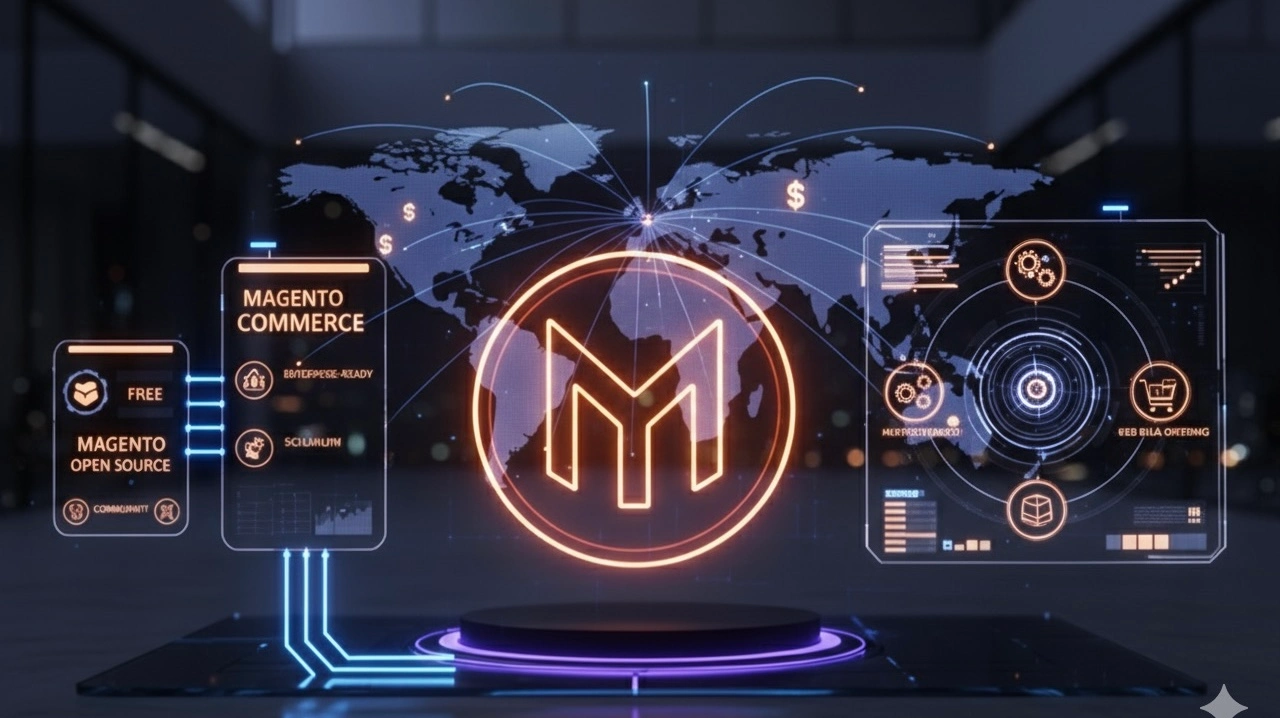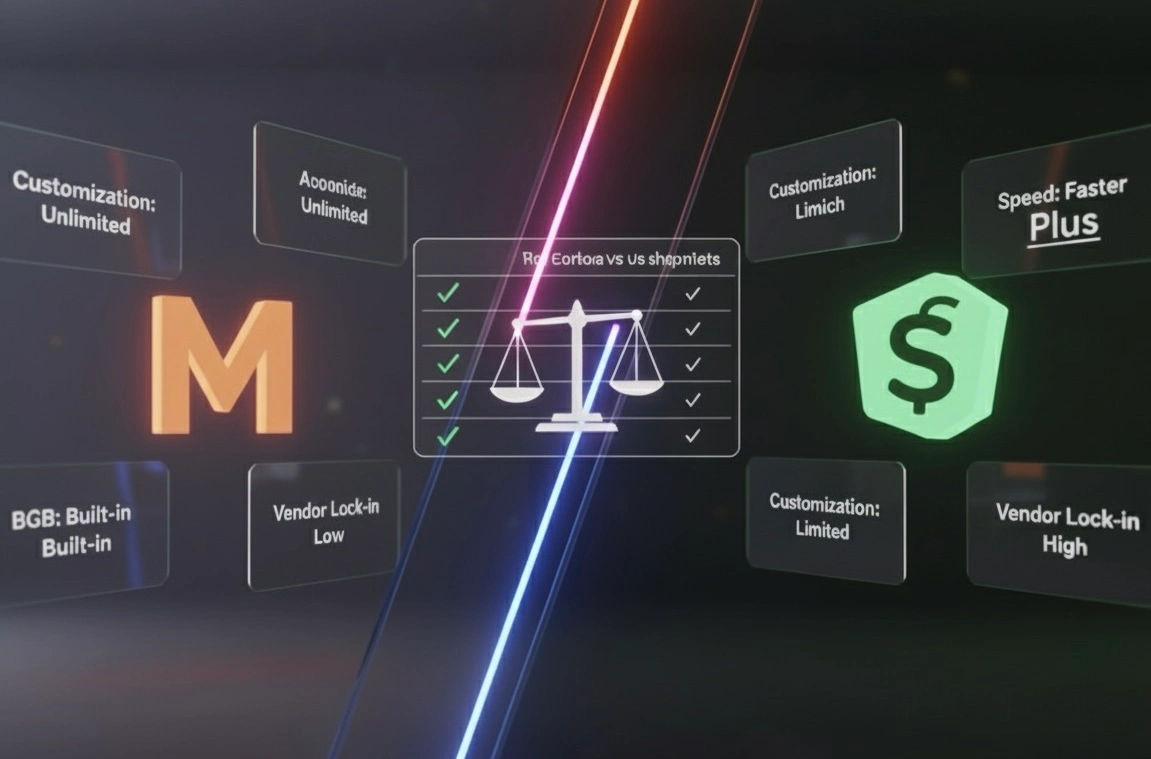Every CEO chasing scale eventually runs into the same problem. Sales are rising, campaigns are landing, and the market looks wide open. Then the website buckles. A product launch slows the checkout page to a crawl. Marketing asks for a new feature, but IT responds with “not possible on this system.” The tools that once felt empowering suddenly turn into obstacles.
This is what we call the growth ceiling. It sneaks up on companies that grew quickly on simpler e-commerce platforms but never built for the next stage. In 2025, when global e-commerce is forecasted to cross $4.8 trillion, getting stuck here is not an option. Competitors who make the right infrastructure bets keep moving while everyone else stalls.
The good news? There’s a clear alternative. Magento for enterprise was built for companies that need more than basic commerce. This article cuts through technical chatter and explains, in CEO language, why Magento is often the smarter long-term investment.
What Magento Really Is (And Who It’s For)
Magento—known in its enterprise form as Adobe Commerce—isn’t just another “shopping cart.” Think of it as a commerce engine that adapts to your business logic, not the other way around.
There are two flavors: Magento Open Source (free, community-led) and Adobe Commerce (licensed, supported, and enterprise-ready). Large companies usually opt for the latter because of the additional tools, support, and scalability it provides.
So how do you know if Magento is the right fit? Ask yourself:
Do you manage a large or complex product catalog, with thousands of SKUs or variations?
Are you looking at deep integration with ERP, CRM, or supply chain systems?
Is international expansion on the horizon—new currencies, tax systems, or languages?
Do you run B2B e-commerce platforms that require bulk orders, corporate accounts, or contract pricing?
Are you expecting growth that will quickly outstrip smaller systems?
If the answer is yes to more than one, Magento should be on your radar. Surrounding the platform is an entire ecosystem—Magento SEO services, Magento UI/UX services, and web development services—that make it practical to operate at scale.
When you look at the data, Magento isn’t a fringe player. Independent surveys in 2025 suggest it’s running well over 130,000 online stores, which gives it close to eight percent of the global e-commerce market. That figure might sound modest next to Shopify’s mass appeal, but it underlines Magento’s position in a very different league—the side of the market where product catalogs are sprawling, integrations are mission-critical, and enterprises need something more robust than a plug-and-play tool.
The Three Pillars That Matter to CEOs
When boards ask why a platform matters, they don’t want code-level details. They want to know: Can it handle our growth? Is it safe? Does it convert customers? Magento ticks all three.
Flexibility and Scalability
Imagine renting a standard office versus designing your own headquarters. Renting is fine until you outgrow it, but customization is limited. Owning lets you add floors, remodel rooms, and future-proof the space. Magento is the headquarters.
It scales for traffic surges, supports multi-warehouse inventory, and allows unique business rules. A fashion chain in Europe once struggled to set up layered promotions in Shopify Plus; after migrating to Magento, they created the exact rules they needed and lifted average order value by nearly 20%. That flexibility translates directly into financial upside.
Security and Control
For large companies, security is no longer something that only the IT team worries about. A breach can knock millions off a brand’s value overnight, so it’s a standing item on board agendas. News cycles keep reminding us how often customer data ends up exposed. Magento’s enterprise edition was built with that reality in mind: the platform is regularly updated with security patches, it helps businesses meet PCI requirements, and it gives leaders the ability to control exactly who has access to what inside the system.
Performance and Optimization
Conversion is fragile. A single second of load delay can tank revenue. Magento supports advanced caching, CDN delivery, and mobile-first UI/UX, which keep performance high even under strain. Many enterprises now build headless commerce setups or Progressive Web Apps on top of Magento for even faster load times. The result: sites that stay stable at peak traffic and consistently load in the 2–3 second window customers expect.
Magento vs. Shopify Plus: A Strategic Comparison
It usually comes down to three pieces: a pain point the audience instantly recognizes, a twist that surprises them, and a repeatable style. Brands that stick to these basics are the ones that consistently create viral marketing videos, instead of banking on one lucky post.
And here’s another one you’ll hear all the time: “How do I get more views on YouTube Shorts?” The answer hasn’t changed much — stay consistent. Post often, lean into trending sounds, and always add a clear CTA that nudges viewers to share, save, or subscribe.
Interactive Content Marketing – Quizzes, Polls & Gamification
This question always comes up: why not just stick with Shopify Plus? The answer isn’t “Magento is better.” It’s “Which platform fits your business model?”
| Factor Magento | Shopify Plus | |
| Cost Over Time | Higher upfront, lower incremental cost at scale | Lower upfront, recurring app fees mount |
| Customization | Unlimited; open architecture | Restricted; tied to app ecosystem |
| B2B Capabilities | Built-in corporate accounts, pricing tiers, workflows | Relies on add-ons |
| Speed to Market | Slower build, but scalable for years | Faster launch, but limited for complex growth |
| Vendor Lock-in | Low; you control infrastructure | High; bound to Shopify |
Shopify Plus works if speed and simplicity outweigh long-term flexibility. But if you see yourself managing multiple brands, regions, or complex B2B rules, Magento’s long-term ROI usually justifies the upfront cost.
Looking at the Real Cost: TCO Explained
The phrase “Magento is expensive” is repeated often. But what’s expensive—a short-term invoice, or a system that blocks your growth and forces a replatform later? CEOs need clarity.
Breakdown of Total Cost of Ownership (TCO):
Licensing: Magento Open Source is free and Adobe Commerce requires subscription.
Hosting & Infrastructure: Cloud hosting with CDN, plus load balancing, failover.
Development: A Magento development company or in-house team builds features.
Maintenance: Security patches, QA testing, and frequent updates keep stability.
Integrations & Extensions: Payment, search, marketing tools.
Operational Overhead: Monitoring, DevOps, compliance.
Now, measure against the return. Faster performance means higher conversions. Stronger SEO means more organic traffic. Better integrations cut labor hours. Case studies show enterprises recovering their Magento investment in 12–18 months, with compounding ROI after that.
When evaluating TCO, CEOs must also consider the hidden costs of migration. If Shopify Plus forces you to replatform in three years, the combined cost is often greater than starting on Magento in the first place.
The Most Critical Decision: Choosing the Right Magento Partner
Magento’s power is undeniable, but that doesn’t mean success comes automatically. For most enterprises, the hardest part is not the platform but the execution. This makes the choice of partner absolutely critical.
Choosing a Magento agency is less about hiring coders and more about finding a partner who can think like a strategist. The right team won’t stop at writing code; they’ll connect your revenue goals to the way the platform is designed, flag where projects could overrun, and suggest smarter ways to protect ROI. Strong agencies usually bring a mix of skills to the table: Magento development service backed by experience in SEO services, thoughtful UI/UX work, and broader digital marketing services. That combination matters because a platform that looks fine on paper but fails to drive sales is only half a solution.
Look for partners with a proven process, enterprise case studies, and transparent communication. They should anticipate complexity, not be surprised by it. At Gonzo Digital, for example, we don’t separate platforms from growth—we design both together. That approach ensures the investment keeps producing returns long after launch.
Conclusion: A Platform for Ambition
Technology should always accelerate the growth and not restrict it. For enterprises in 2025, Magento for enterprise is one of the few platforms that can handle complexity while leaving room to innovate.
Magento gives enterprises the room to grow, the security to protect what matters, and the speed to convert visitors into paying customers. Still, software alone doesn’t guarantee results. Much depends on the partner you bring in—choose poorly and Magento becomes an expensive headache; choose wisely and it turns into the foundation for your next growth chapter.
A commerce platform shouldn’t just keep up with business ambitions. At its best, it should push them forward.
FAQ
Is Magento good for large business?
Yes. Magento is widely used by enterprises that manage big catalogs, handle complex operations, or sell in multiple regions. Its flexibility makes it suitable for large businesses that can’t afford the limits of lighter platforms.
Why use Magento for e-commerce?
Magento offers control and customization that closed platforms rarely provide. With enterprise-grade security, performance optimization, and deep integration options, it allows companies to innovate freely and scale without replatforming every few years.
What is the total cost of ownership for Magento?
The cost depends on licensing, hosting, development, and maintenance. While upfront investment is higher than SaaS platforms, most enterprises see measurable ROI within 12–18 months.
How does Magento compare with Shopify Plus for enterprises?
Shopify Plus is faster to launch, but Magento is more flexible long term. Enterprises needing B2B e-commerce platforms, complex integrations, or international scale usually find Magento the stronger option.





